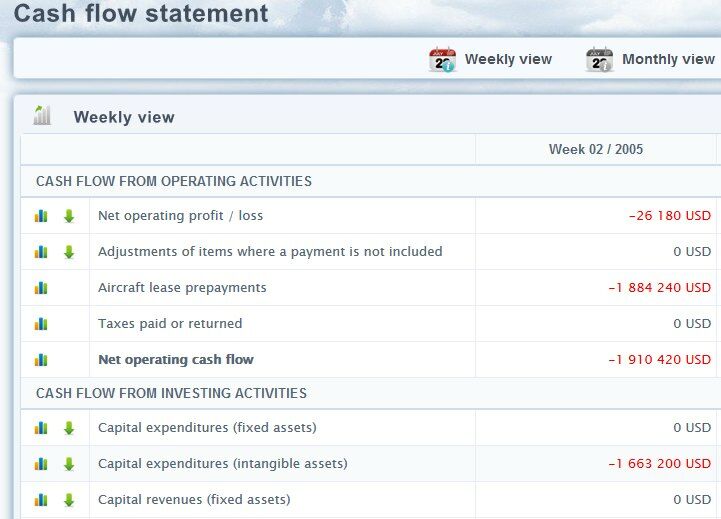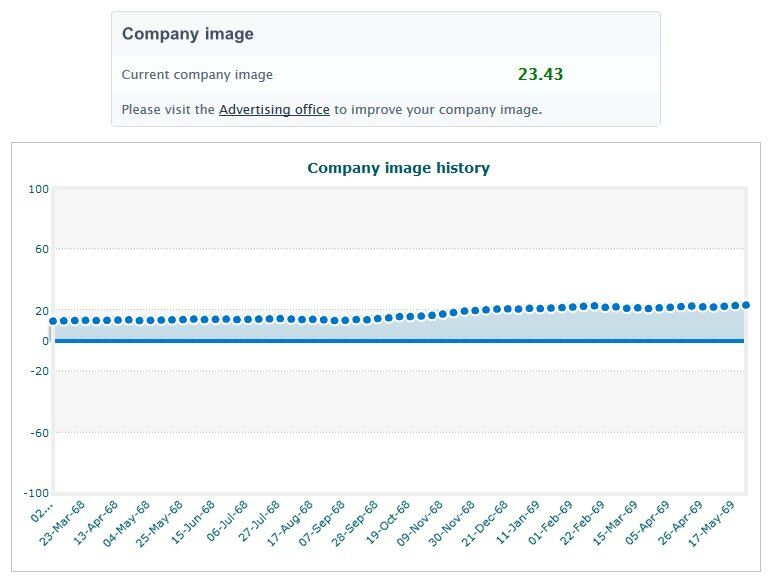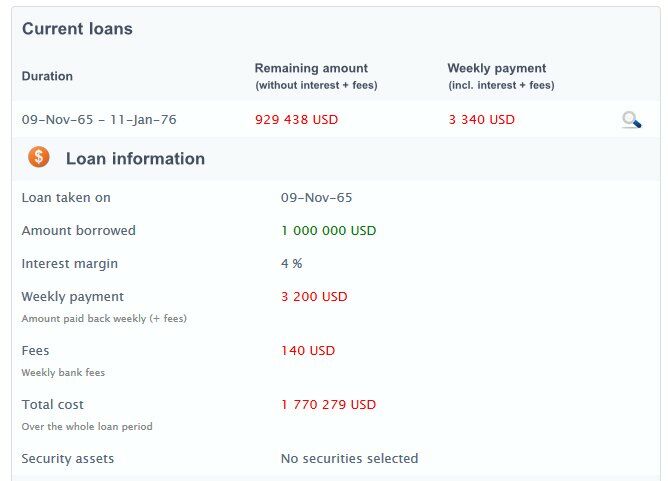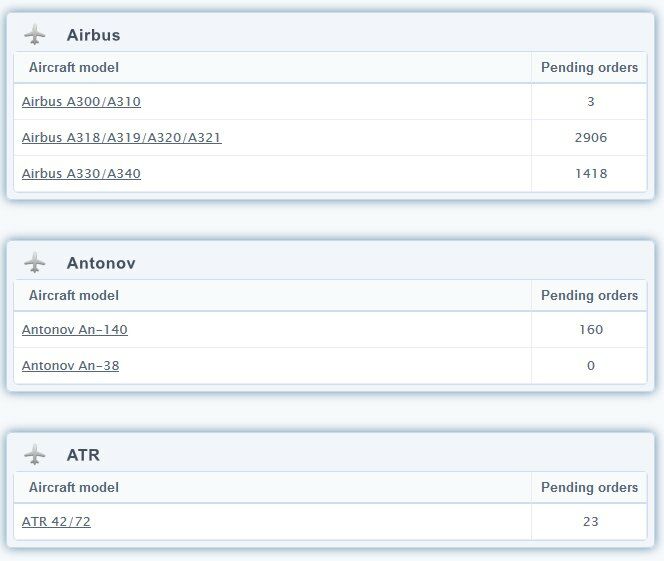In this third chapter of the beginner's guide, we will give you background information and tips on how to keep your airline going after the first steps. By now, you should have the airline running with a handful of aircraft and routes.
Cash Reserves
As already mentioned previously, you should be very careful with your cash when you start up.
Start carefully with a handful of aircraft and establish a secure foothold until you expand further.
Keep in mind that if you are out of cash, you cannot do certain things like open new routes anymore. But also keep in mind, that you need certain number of routes and planes to cover the general cost overhead (staff, marketing, office space) before you can gain profits - so flying just one aircraft is not enough!
You can use the Cash Flow Statement to keep track on where your money goes.
Route Image
The concept of Route Image was briefly mentioned previously, a few more words on that: When you start a new route to a new destination it will be unknown to most of the public.
This means that you have to cope with low load factors and low profits for the first 6-12 months depending on how aggressive (and expensive) your marketing is. For any new airline, load factors between 30-60% are normal at the beginning. Some of your routes may also fly making losses. Be prepared for this and keep money in the reserve!
When you open up new routes as a new airline, or even later on when you open up a route to a new destination not served before, it's always a good idea to lower the ticket prices initially by 10-20% especially if there are other airlines flying the route.
As the airline or the route you are serving is unknown to the public, using lower ticket prices will help to raise the awareness a little bit and resulting in higher load factors. However, do not drop the prices too much as otherwise the profits will start to suffer - try to find the balance.
When opening a new destination you should expect the public to be fully aware of the new route about 10-14 months after it has been opened. So, it is very uneconomical to open and close routes all the time as you cannot see the true public interest on the route in a short time. When time passes, remember to raise the ticket prices again. When your airline is more established, the people will pay more to fly with you so do not give out your services too cheaply!
You can enhance the public knowledge of a new route/destination by creating Route Marketing campaigns from the Marketing page. Such a campaign will raise your Route Image faster, making this particular route known to the public faster.
This is a separate concept from the Company Image, which is your airline's overall brand recognition.
Ticket Prices
Pricing is an important factor for any operation. The common pitfall however is the thought that a 100% Load Factor would be desirable - it is not.
The main goal and primary aim of each airline is to maximize their revenue and profit. You should be active and adjust the ticket prices of your routes in order to find the optimum balance between route sales and profits.
Usually the sweet spot where you can charge maximum possible prices with minimal loss of travellers is somewhere between 70 and 90% load factors. The system does suggest ticket prices for you on each route but these suggestions are based merely on the route type and length for example - the system does not take into account competition or other route parameters, it's your job.
The pricing very much depends on all specific details, like amount and type of competition on the route and the service you provide. For example, you cannot charge high prices if your route departs at 02am, in the middle of the night. Nor can you do that if the route is heavily over-served by other airlines already. But, where you can, on routes where you are the sole airline for example, feel confident in increasing the prices and trying to maximize the route profits.
You can see each route's exact sales, profit and expense figures on the route management pages in high detail.
Marketing
The basics of marketing were already covered earlier. But as a reminder: you must have active marketing campaigns running all the time. As shown in the previous chapter you can market in radio, TV, newspapers etc.
The bigger the marketing campaign is the higher the costs - it is also more effective (loosely stated price is directly proportional to effectiveness). Selected advertising medias and locations also affect the cost and also the campaign effectiveness. Advertising on local newspaper is a totally different deal compared to global TV campaign. Cost is very different but so is the effect on your image too. Remember also that the costs rise when your airline grows larger.
Keep in mind that bad things happening to your airline will lower the overall company image and that in turn will have a decreasing effect on the route sales in long term. If you do not do your aircraft maintenance on time and you are busted for that you will get a noticeable fine and public image loss for example - with marketing you can compensate for these mistakes. Also the mishaps in daily operations affect the image, in good or bad. For example, excessive flight delays or cancellations are a big problem for the image. On the other hand, if your airline flies punctually on the scheduled times, you will get a free word-of-mouth marketing from the happy customers.
Same goes for your staff - their morale is directly affecting the company image. If your staff is happy, the customers will also be happier and willing to travel with your airline again. If you let the staff morale degrade, it will also lead to unnecessary flight delays as unmotivated staff are not interested in working with proper procedures.
Loans
If things do not go well, despite of all planning, you have the option to take out a loan from the bank.
Loans have variable interest rates which are sometimes high and bank administrational fees are not very generous. However, an additional loan can save you if you have a tricky spot. The loans will also help you to expand more rapidly. You can get a loan and then purchase/lease more aircraft for example, and you can also use your owned assets as loan securities to get even bigger loans.
Loans are tied to the market interest rates which change every month. You can see the current rate from Loans page of the game.
For each loan, you pay the loan down payment itself, loan interest added with interest margin and also a small weekly processing fee to the bank. Loans are paid back automatically according to their terms. You also have the option to pay the whole loan back early but this includes some additional fees.
For all loans, always make sure you have cash in your account as otherwise if the loan payment fails the bank may lower your credit rating or seize some assets of your company to secure the money.
Aircraft Maintenance
When you decide to acquire more aircraft for the company, you should follow the same procedure as with the first ones, all of which was explained in the previous chapters.
For a startup airline, it is not advised to buy or lease brand new planes as their cost is high. A 5-15 year old aircraft from the used market that is in good condition with a fresh C/D check is the key.
Keep in mind that when the plane is in maintenance, it will not generate any revenue but all the staff expenses will keep running. So when scouting for additional aircraft to your fleet, do not accept an aircraft that will soon need a C/D check, unless you absolutely can afford it.
Fleet Commonality
Secondly, and perhaps one of the most important things to look for is the aircraft model which determines the fleet commonality. We have mentioned this already before, but the importance of this can't be emphasized too much.
For a fleet of 20 aircraft or less, a single aircraft type is recommended. In the used aircraft market's limited supply this is not always possible. But, if you do not see suitable planes on the day you look, you can wait for some time to see if they appear later - the AI aircraft brokers and other airlines have something new to sell on regular intervals.
Planning your aircraft fleet wisely is the cornerstone to success. Remember also to first scout for suitable routes to narrow down your aircraft needs. Do not just buy a B747 because it looks to be so nice. First check to see if you really need one!
New Aircraft
When you are in the startup phases of the new airline, do not worry about getting new planes too soon.
Make lease deals for used aircraft for 1-4 years and build up a nice fleet of rather new planes (5-15 yo.) in good condition. They are good value for money if you keep them in shape with regular normal maintenance.
When you have expanded the airline and the lease deals for the first aircraft are ending, it is a good idea to check the offerings from the aircraft manufacturers. If you strike a deal for a new aircraft model and become a launch customer you may receive a nice discount of over 20%. However, getting new aircraft is expensive and the delivery will take a long time (depending on the model even years!).
Aircraft in the simulation do not appear out of nowhere but the manufacturers have to build them. In worst case, there can be a 500+ aircraft order backlogs on some models which mean that you have to wait for the aircraft to be delivered for several game years. And still you must pay the down payment for the order so all that money is tied elsewhere until you actually receive the planes. So look closely for the aircraft production slot lists and queues!
It is also still worth checking the used aircraft listings as usually you can find there some "almost new" aircraft (less than 2 yrs old). These come from bankrupt airlines and also from other active airlines that act as aircraft brokers. Compared to a long waiting from the manufacturer these may be worth the money if you find proper models available.
Though having owned aircraft always poses the risk of not being able to sell or lease the planes forward when you have no use for them anymore. But leasing is still more expensive as the lease company takes their share and also requires keeping the most expensive insurances on the aircraft. It's a balance and a business decision.
Common Mistakes
It may happen that your airline does not get off the ground as well as you’ve hoped for … There are many possible reasons for this as there are different players, but we’ve collected some common mistakes and tips here:
Poor scheduling
- Like already pointed out your flight schedules should be very efficient.
- Avoid the white space (= no flight / maintenance, plane is just sitting idle).
- However flying short flights in the middle of the night is not advisable.
Too few aircraft
- An airline with only 1 or 2 aircraft will usually fail. There are certain fixed costs and fees that won’t be fully covered (or it will be very difficult).
- You should have at least 5+ aircraft in your fleet.
- However don’t expand too rapidly. You should always keep a reasonable cash reserve.
Fleet commonality
- The concept of “fleet commonality” was briefly described earlier. This is basically a model of training and administrative costs associated in keeping each of your different aircraft types flying.
- If you have many different types in operation these costs will be higher.
- Generally speaking, you should not have any more than 1-3 different aircraft fleet groups in operation, and especially when you start your airline the first 4-5 aircraft should always be of the same type.
Route’s ticket pricing
- The system will suggest ticket prices for your newly created routes. When you start it may be a good idea to reduce these prices a bit in order to gain more passengers. But, you shouldn’t forget the prices at these lowered levels when time passes.
- The simulation has a concept called “Route image” which basically measures how general public knows each of your routes. When you start a new route, only a handful of people know of this. But, later on when the information spreads, you can raise the ticket prices too.
- All pricings should depend on your sales and Load Factor of course. But, keep in mind that you should not aim for the highest possible load factor but instead to the highest possible profits. Selling 100% of the seats is not a good idea, since in that case you could have sold only let’s say 95% of the seats but with 20% higher prices.
- The optimal pricing of the routes is a combination of many things and needs some testing from your side over time.
If you feel that your airline cannot survive, you can use the ‘Declare bankruptcy’ function (found under Office) to restart. This will basically mean that you close down your current airline and start all over again.
Join the Community
Support in all gameplay related issues is available from our forums and at our Discord channel.
At our forums, please post your question to the proper subforum for fastest possible reply from the community.
Please also consult other parts of our documentation at this website for a deeper understanding of the simulation.
Now good luck with the airline. Remember to check back often and plan any major changes wisely. 🥳








